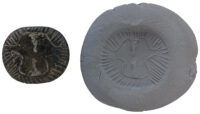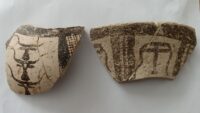 A unique seal incised with stylized bull heads facing each other has been unearthed at the Domuztepe Mound, a Late Neolithic settlement in southeast Turkey. The button-shaped stamp seal features two animal heads mirroring each other on the surface of an oval serpentine stone. Around the edge is a border of radiating straight lines.
A unique seal incised with stylized bull heads facing each other has been unearthed at the Domuztepe Mound, a Late Neolithic settlement in southeast Turkey. The button-shaped stamp seal features two animal heads mirroring each other on the surface of an oval serpentine stone. Around the edge is a border of radiating straight lines.
 Domuztepe is the largest known settlement of the Halaf culture, a farming society that occupied northern Mesopotamia and Syria between around 6100 B.C. and 5100 B.C. They are renown for the unusually high quality of pottery they produced from local clay. Their painted polychrome ceramics were so highly prized they spread throughout the region, likely traded by the elites. The pots were decorated with finely-executed geometric or animal designs in brown, red and/or black (both iron oxide pigments) against a buff background.
Domuztepe is the largest known settlement of the Halaf culture, a farming society that occupied northern Mesopotamia and Syria between around 6100 B.C. and 5100 B.C. They are renown for the unusually high quality of pottery they produced from local clay. Their painted polychrome ceramics were so highly prized they spread throughout the region, likely traded by the elites. The pots were decorated with finely-executed geometric or animal designs in brown, red and/or black (both iron oxide pigments) against a buff background.
The Halaf culture is responsible for the earliest known stamp seals on the archaeological record. Halaf seals were typically simple circles or rectangles incised with intersecting grid lines and chevrons. One example in the Metropolitan Museum of Art is notable for having a zoomorphic shape believed to represent a hedgehog, but the surface design is still a simple grid with exes in each cell.
The newly-discovered seal employs a motif previously only found on pottery: the bull or buffalo head. The shape of the horns and head painted on the pottery is different from the design on the seal. It could be that one style is meant to represent domestic cattle and the other water buffalo, but they could also both be domestic bulls with two different, highly stylized designs.
[T]he bullheads visualized on different materials are mostly accepted as the representative of the species known as domestic cattle (Bos Taurus) in the Near East. On the other hand, it is possible that the species in the samples shaped both as a paint decoration on pottery and by scraping on seal impressions is a water buffalo (bos bubalis). Since archaeozoological studies have not been completed yet, it is premature to say that water buffalo was domesticated in the Eastern Mediterranean, where Domuztepe is located, in the 7th-6th millennium BC.
Clearly, “bureaucracy” was invented long before the bureau 🦌️
That’s a classic, on the other hand, a “Bucranium” or βουκράνιον (βοῦς = ox, κρανίον = skull), heads of sacrificed bulls used in ornamental and maybe hierarchical symbolism, like today people use Christian crosses.
Tell Halaf, obviously close to “Tell Domuztepe”, is by just a few hundred meters already in what today is Syria.
:hattip: